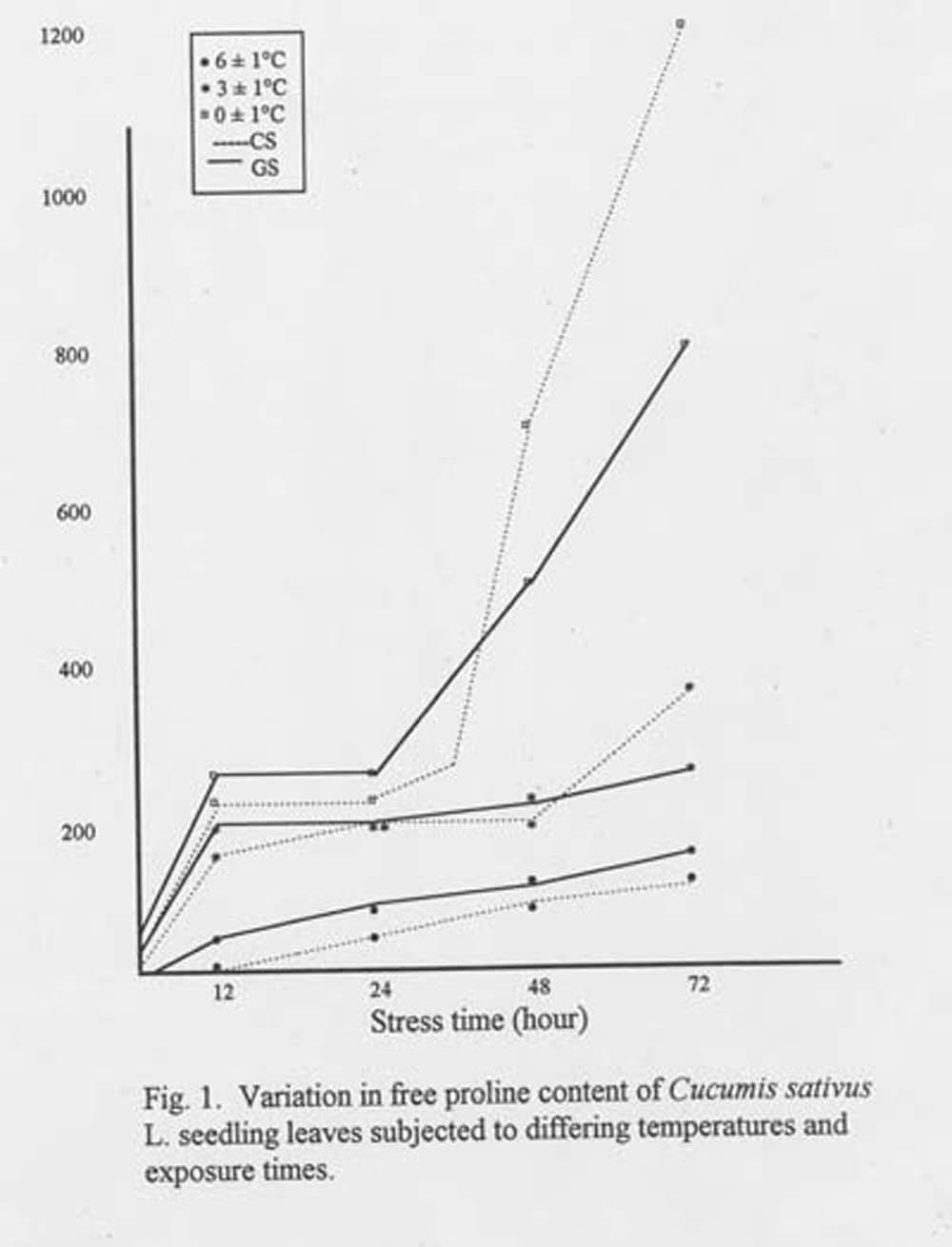Cucurbit Genetics Cooperative Report 19:25-29 (article 9) 1996
Jiqing Wang
Dept. Horticulture, Henan Agric. Univ. Zhengzhou, Henan, 450002, P.R. China
Hongwei Cui
Dept. Horticulture, Northwestern Agric. Univ. Yangling, Shaanzi, 71200, P.R. China
Introduction. Recently a greenhouse industry has rapidly emerged in some areas of China. Grafting cucumber seedling onto the rootstock of Cucurbita ficifolia is an effective way of obtaining high yields from greenhouse cucumber varieties during the winter and early spring. Studies relating to the characterization of chilling tolerance in cucumber (Cucumis sativus L.) are important. Elucidation of the biochemical mechanism of graft facilitated chilling tolerance in cucumber might lead to improved environmental management technologies.
Materials and Methods. The seedlings of ‘Shangdong Thom’ (CS) cucumber were grafted onto Cucurbita ficifolia (GS) and were then evaluated under artificially-induced low temperature stress (0 +1 C, 3 + 1 C and 6 + 1 C). The content of free proline (CFP) in the leaves of seedlings under temperature stress were examined at 12h, 24h, 48h and 72h after stress initiation. Experimental treatments were arranged in a randomized complete block design with 3 replications.
Result and Analysis. During the low temperature stress, the CFP in CS and GS was similar under different low temperature stress conditions (Figure 1). The CFP increased during the exposure period. This increase in CFP varied among treatment temperatures. After 72h at 0 +1 C, CFP of CS plants attained 1209.2 μg/g DW (i.e., a 46.7 fold increase), while the CFP of GS plants attained 830.7 μg/g DW from a base CFP of 25.3 μg/g DW (i.e., a 31.8 fold increase). During the same exposure period, the CFP of CS plants held at 3+1C increased by 14.8 fold, and plants at 6+1C increased 4.5 fold. The CFP of GS plants held at 3+1C increased 9.1 fold and plants held at 6+1C increased 9.1 fold. Plants held at 0+1C experienced an increase in the range of CFP at 12h and 24h regardless of genotype. Similar results occurred at 12h for CS and GS when plants were held at 3+1C. However, a second increase in CFP occurred after 48 h in CS plants, and CFP increased slightly after 24h in GS plants. There was a slight increase in the CFP of CS and GS plants held at 6+1C.
The expression of chilling damage occurred later in GS than in CS plants. The degree of damage observed in GS plants was slightly less than that in CS plants under different temperature stress regimes. After assessing the relationship between CFP content and chilling damage, it might be hypothesized that the observed increase in CFP during increasing stress exposure is an indication of cucumber’s adaptation to the low temperature. In most instances higher CFP values in cucumber resulted in higher tolerance to low temperatures. The second rapid increase period of CFP is associated with the expression index of chilling damage in cucumber.
Figure 1. Variation in free proline content of Cucumis sativus L. seedling leaves subjected to differing temperatures and exposure times.

Literature Cited
- Tang, Z.C. 1984. Accumulation of proline in stressed plants and its possible significance. Plant Physiology Communications 1:15-21.
- Handa, S. et al. 1986. Proline accumulation and the adaptation of cultured plant cells to water stress. Plant Physiol. 80:938-945.
- Carpita, N.C. 1986. Incorporation of proline and aromatic amino acids into cell walls of maize of coleoptiiles. Plant Physiol. 80:660-666.
- Stewart, C.R. et al. 1986. The effects of benzyladenine, cycloheximide, and cordycepin on wilting-induced abscisic acid and proline accumulations in barley. Plant. Physiol. 82:703-707.
- Paleg, L.G. et al. 1984. Proline and glycine betaine influence protein solvation. Plant. Physiol. 75:974-978.